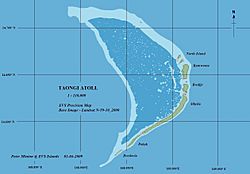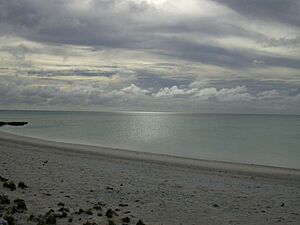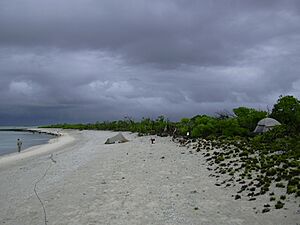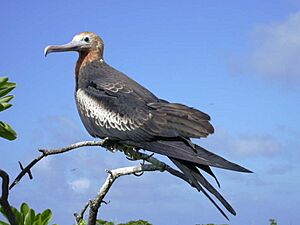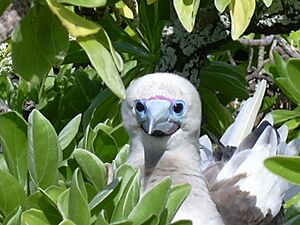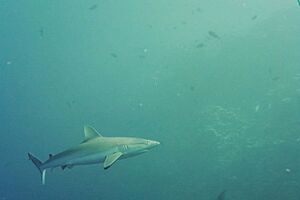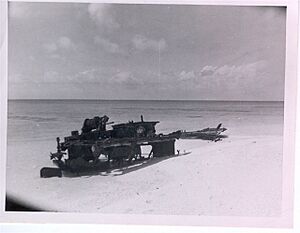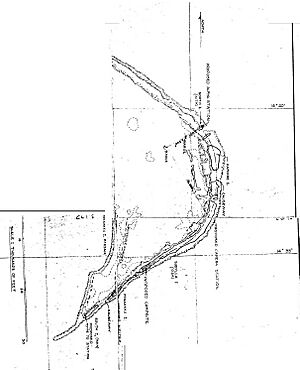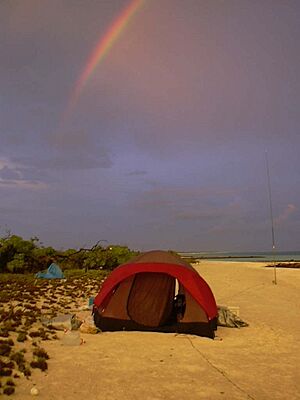Bokak Atoll facts for kids
Bokak Atoll (also called Taongi Atoll) is a special place in the Marshall Islands. It's a coral atoll in the North Pacific Ocean. An atoll is a ring-shaped island made of coral, surrounding a lagoon.
Bokak Atoll is not lived on by people. It's part of the Ratak Chain of islands. Because it's far away from other islands, its plants and animals are very natural. They haven't been changed by people or new species brought in.
Contents
Exploring Bokak Atoll
Where is Bokak Atoll?
Bokak Atoll is about 685 kilometers (426 miles) north of Majuro Atoll. Majuro is the capital of the Marshall Islands. Bokak is also 280 kilometers (174 miles) northeast of Bikar Atoll. This makes Bokak the most northern and most isolated atoll in the country. Wake Island is about 348 miles (560 km) to the north-northwest.
The land area of Bokak is small, only 3.2 square kilometers (1.2 square miles). But its central water area, called a lagoon, is much bigger. The lagoon measures 78 square kilometers (30 square miles). The atoll has 36 tiny islands, called islets. The total area, including the reef, is 129 square kilometers (50 square miles).
What Bokak Atoll Looks Like
Bokak Atoll is shaped a bit like a crescent moon. It is about 18 kilometers (11 miles) long and 9 kilometers (5.6 miles) wide. It runs from north to south. The coral reef around the atoll is mostly solid. There's only one small opening, about 20 meters (66 feet) wide, on the west side.
Ten islets sit on the eastern and southeastern parts of the reef. The main islets are North Island, Kamwome, Bwdije, Sibylla, Bokak, and Bwokwla. Sibylla is the biggest islet. It's about 7.2 kilometers (4.5 miles) long. Kamwome Islet is the second largest. The atoll is named after Bokak (Taongi) islet, which is south of Sibylla.
Scientists believe Bokak Atoll has a huge coral base. This coral base is about 1,400 meters (4,600 feet) thick. It sits on top of a basalt rock base. Basalt is a type of volcanic rock. This huge coral base shows that the old volcano underneath has slowly sunk over time. The volcano itself rises 3,000 meters (9,800 feet) from the ocean floor.
The islets have high ridges of boulders and sand. This shows that strong storms have hit the atoll in the past. The soil on the islets is very young. It's mostly a mix of coral sand and gravel. There's not much rich soil (humus).
The lagoon inside the atoll is shallow, probably less than 30 meters (98 feet) deep. It has many coral heads and small reefs. Some of these even reach the surface of the water. The water level in the lagoon is about 1 meter (3 feet) higher than the ocean. This happens because wind pushes ocean water over the reef. There's only one narrow opening for the water to flow out.
Weather in Bokak Atoll
Bokak is the driest of all the Marshall Islands atolls. It has a semi-arid climate, which means it's very dry. The average temperature is about 28 degrees Celsius (82 degrees Fahrenheit). It gets less than 1,000 millimeters (39 inches) of rain each year. Most of the rain falls in late summer. The winds usually blow from the north to the northeast.
Plants of Bokak Atoll
Bokak Atoll has only nine types of plants. All of these plants are native to the Marshall Islands. This means they grew there naturally and haven't been disturbed by plants brought in by people.
Because it's so dry, with good drainage and high temperatures, coconut trees can't grow here. The most common plant is a low, thin scrub forest of tree heliotrope. These trees are usually 2 to 6 meters (7 to 20 feet) tall. Sometimes there are taller ones.
Under these trees, you'll find beach maupaka shrubs. You might also see sparse bunchgrass, ʻihi, ʻilima, or alena. Alena grows more on broken coral gravel. A small group of Pisonia grandis trees can be found on Kamwome Islet and a tiny spot on Sibylla.
Thick areas of beach naupaka shrubs are very common. They cover most of the southern and northeastern parts of Sibylla. The plant areas dominated by Heliotropium, Scaevola, Sida, and sandy bunchgrass are some of the best examples of these plants in the Pacific.
In the shallow parts of the lagoon, you'll find sparse coralline algae. There are also bits of coral and shells covered in algae. Patches of green seaweed grow there too.
Animals of Bokak Atoll
Bokak Atoll is home to many sea and shorebirds. Up to 26 different kinds of birds can be found there. Some birds that breed here include the brown booby, red-footed booby, great frigatebird, red-tailed tropicbird, sooty tern, white tern, and brown noddy. The Pacific reef heron might also breed here.
Many birds migrate to Bokak Atoll. These include the bristle-thighed curlew, turnstone, wandering tattler, golden plover, and sanderling. The most birds are found on three islets north of Sibylla: North (Kita), Kamwome, and an unnamed islet. Bokak is the only known place where the Christmas shearwater breeds. It might also be a breeding ground for Bulwer's petrel.
On land, you can find the Polynesian rat on Sibylla. The more aggressive black rat is not found here. This is good for the local wildlife. You can also see snake-eyed skinks and many large hermit crabs.
The ocean animals around Bokak are healthy, but there aren't many different kinds. This might be because the atoll is so isolated. Researchers haven't seen any sea turtles, but local traditions suggest they are present. Giant clams are very common, except for the largest kind, Tridacna gigas. Smaller clams are also present.
The reef fish are mostly emperor breams, parrotfish, and red snappers. You can also find moray eels and grey reef sharks. There are about 100 types of stony corals and two types of soft corals.
History of Bokak Atoll
Early Times
People came to the Marshall Islands about 2,000 years ago. But there are no signs that people lived on Bokak Atoll for a long time. The dry climate, lack of fresh water, and poor soil made it hard to live there. It's likely the atoll will stay uninhabited.
However, people from other atolls in the northern Ratak chain used Bokak. They would visit to hunt and gather, especially for seabirds. The chiefs (Iroji Lablab) of the Ratak atoll chain traditionally owned Bokak. They managed the hunting of sea turtles, birds, and eggs.
From the 1500s to the 1800s
The first European to see Bokak was Toribio Alonso de Salazar. He was a Spanish explorer who saw it on August 22, 1526. He named it San Bartolome. Another Spanish naval officer, Fernando Quintano, explored it in 1795. Many other Western ships saw or landed on Bokak over the next 300 years. But no one tried to settle there or bring farm animals. This was probably because of the dry conditions.
In 1906, the Marshall Islands became part of German New Guinea. The Germans took control of Bokak Atoll, saying it was unclaimed land. The local chiefs protested, but the Germans ignored them. Later, the Germans noticed Japanese people poaching birds. They cared more about protecting their own control than the islanders' interests.
The 1900s to Today
In 1914, Japan took over the Marshall Islands. They also took control of Bokak from the Germans. Like the Germans, the Japanese didn't try to use the atoll much. The local Marshallese people continued to hunt and fish there.
During the 1940s, Japan built a small seaplane and communication outpost on Sibylla Island. This was part of their military plans for the Marshall Islands during World War II. In March 1943, the 20 soldiers stationed there were moved to Wake Island. They couldn't find enough food to survive on Bokak. American planes bombed the abandoned outpost in April 1944.
After battles with Japanese forces in 1944, the Marshall Islands came under American control. In September 1945, after the war, an American ship searched Bokak Atoll. They were looking for any Japanese soldiers who might have been left behind. They searched for two days but found no one.
In April 1953, an American ship called LST 1138 stopped at Bokak. They were also looking for any Japanese soldiers who might have been hiding. They found the remains of the wartime outpost but no people.
In 1954, there was a large amount of radioactive fallout from a nuclear test on Bikini Atoll. After this, scientists flew over Bokak Atoll to measure radiation levels. They found some radiation, but it dropped quickly. In 1957, Bokak was considered as a place for nuclear weapons testing. But it would have needed too many changes, so other sites were used instead. Later, it was considered again, but leaders decided it would cause too many problems to test nuclear weapons in a United Nations Trust Territory.
Bokak Atoll was involved in a mystery in 1979. Five men from Maui, Hawaii, went missing in their boat. In 1988, their boat and the remains of one of the men were found on Bokak. The atoll was 3,760 kilometers (2,336 miles) away from where they started.
In 1988, a company suggested using Bokak's lagoon as a huge dump for trash. They wanted to ship millions of tons of waste there.
In August 2003, two amateur radio fans from Texas camped on Sibylla Island. They set up the first ham radio station on Taongi. They used the call sign V73T.
A group called the Dominion of Melchizedek has claimed control over Bokak. They say they have a lease from the local chiefs. However, this group is not recognized as a country. Their claim is not valid under the government of the Marshall Islands.
Today, you can still find old remains on Bokak. These include an abandoned camp, several wrecked ships, and parts of the old Japanese communication outpost from World War II.
See also
 In Spanish: Atolón Bokak para niños
In Spanish: Atolón Bokak para niños
- Desert island
- List of islands
Images for kids


